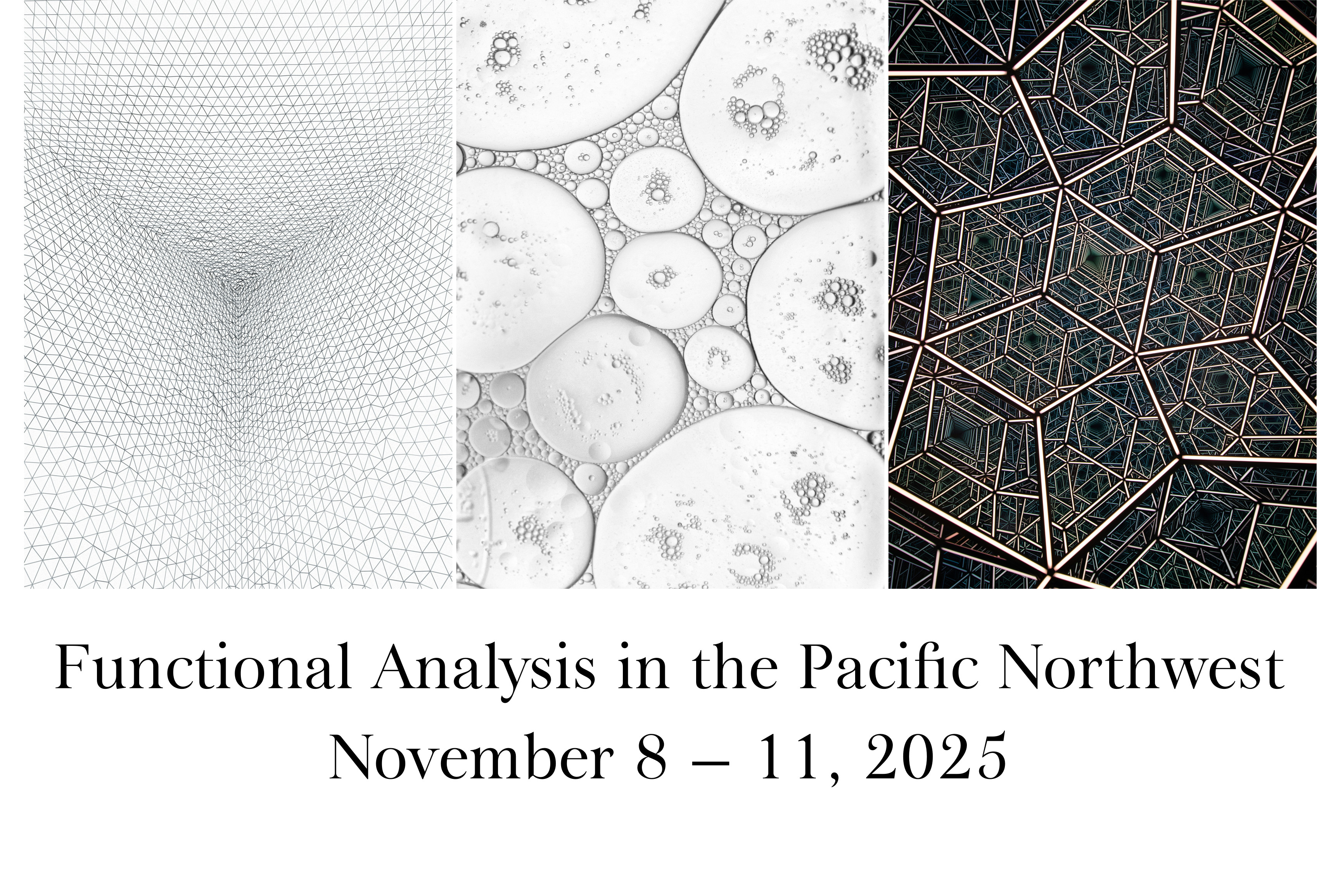The conference will start at about 8:30am on Saturday November 8th and will end at around lunchtime on Tuesday November 11th.
The talks for Saturday and Sunday will be in Fenton Hall 110 (with the registration and coffee being in Fenton Hall Lounge 219).
The Conference Dinner on Sunday evening will be in Gerlinger Hall.
The talks for Monday will be in Erb Memorial Union Rooms 231-232 (Cedar and Spruce).
The talks for Tuesday will be back in Fenton Hall 110.
Link to the Conference Booklet in pdf form.
Schedule
| Saturday November 8th |
|---|
| 8:30 - 8:45
Registration $\to$ Fenton Hall Lounge Room 219 |
| 8:45 - 9:00
Opening Remarks $\to$ Fenton Hall Room 110 |
|
9:00 - 9:50 $~+~$ 9:50 - 9:55
Thomas Schlumprecht – On asymptotic properties of Banach spaces.
|
| 10:00 - 10:30
Coffee Break $\to$ Fenton Hall Lounge Room 219 |
|
10:30 - 11:20 $~+~$ 11:20 - 11:25
Christian Rosendal – Mean operators for (skew) amenable groups.
|
|
11:30 - 11:50 $~+~$ 11:50 - 11:55
Narcisse Randrianantoanina – Interpolations of martingale Hardy spaces.
|
| Noon - 1:30
Lunch Break |
|
1:30 - 2:20 $~+~$ 2:20 - 2:25
Mark Rudelson – When a system of real quadratic equations has a solution.
|
|
2:30 - 2:50 $~+~$ 2:50 - 2:55
Paul Simanjuntak – Stochastic dominance for products of random matrices.
|
| 3:00 - 3:30
Coffee Break $\to$ Fenton Hall Lounge Room 219 |
|
3:30 - 3:50 $~+~$ 3:50 - 3:55
Dorsa Ghoreishi – Discretizing the $L_p$ norm and frame theory.
|
|
4:00 - 4:20 $~+~$ 4:20 - 4:25
Pu-Ting Yu – Operations that are incompatible with frames of translates.
|
|
4:30 - 4:50 $~+~$ 4:50 - 4:55
Alejandro Chavez-Dominguez – Dynamical sampling in Banach spaces.
|
| Sunday November 9th |
|---|
| 8:45 - 9:00
Registration $\to$ Fenton Hall Lounge Room 219 |
|
9:00 - 9:50 $~+~$ 9:50 - 9:55
Chris Philips – Incompressibility and Calkin algebras.
|
| 10:00 - 10:30
Coffee Break $\to$ Fenton Hall Lounge Room 219 |
|
10:30 - 10:50 $~+~$ 10:50 - 10:55
Anna Pelczar-Barwacz – $2^{\mathfrak{c}}$ closed operator ideals on Banach spaces.
|
|
11:00 - 11:20 $~+~$ 11:20 - 11:25
Kevin Beanland – Some new properties of Schreier sets and Tsirelson spaces.
|
|
11:30 - 11:50 $~+~$ 11:50 - 11:55
Bentuo Zheng – Ball Covering Property for classical Banach spaces.
|
| 12:00 - 12:15
Group Picture |
| 12:15 - 1:30
Lunch Break |
|
1:30 - 2:20 $~+~$ 2:20 - 2:25
Stephen Dilworth – Transportation cost spaces and invariant projections.
|
|
2:30 - 2:50 $~+~$ 2:50 - 2:55
Chris Gartland – $L_1$-distortion of transportation cost Banach spaces over graphs.
|
| 3:00 - 3:30
Coffee Break $\to$ Fenton Hall Lounge Room 219 |
|
3:30 - 3:50 $~+~$ 3:50 - 3:55
Bruno Braga – On homeomorphisms between the spheres of $\ell_\infty^k$ and $\ell_1^k$.
|
|
4:00 - 4:20 $~+~$ 4:20 - 4:25
Tomasz Kania – The $\pi$-property along a filter.
|
| 4:30 - 5:20
Open Problem Session – Thirty minutes to one hour. $\to$ Fenton Hall Room 110 |
| 5:30 - 9:30
Conference Dinner – We anticipate drinks to be available from 5:30pm and dinner to be served at about 6pm or 6:30pm. $\to$ Gerlinger Hall |
| Monday November 10th |
|---|
|
9:00 - 9:50 $~+~$ 9:50 - 9:55
Marianna Csörnyei – Embeddings into Euclidean spaces without shrinking.
|
| 10:00 - 10:30
Coffee Break $\to$ EMU 231-232 (Cedar and Spruce) |
|
10:30 - 10:50 $~+~$ 10:50 - 10:55
Seung-Yeon Ryoo – A conjectural low-dimensional embedding of doubling metric spaces.
|
|
11:00 - 11:20 $~+~$ 11:20 - 11:25
Beata Randrianantoanina – Bi-Lipschitz properties of lamplighter graphs on weighted trees.
|
|
11:30 - 11:50 $~+~$ 11:50 - 11:55
Florent Baudier – On asymptotic B-convexity and infratype.
|
| Noon - 1:30
Lunch Break |
|
1:30 - 1:50 $~+~$ 1:50 - 1:55
Mitchell Taylor – Basic sequences in Banach lattices.
|
|
2:00 - 2:20 $~+~$ 2:20 - 2:25
Vladimir Troitsky – Free Banach lattices.
|
|
2:30 - 2:50 $~+~$ 2:50 - 2:55
Mary Angelica Tursi – Universal lattice homomorphisms.
|
| 3:00 - 3:30
Coffee Break $\to$ EMU 231-232 (Cedar and Spruce) |
|
3:30 - 3:50 $~+~$ 3:50 - 3:55
Beatrice-Helen Vristiou – Regular ellipsoids for non-symmetric convex bodies.
|
|
4:00 - 4:20 $~+~$ 4:20 - 4:25
Artem Zvavitch – Weighted Brunn–Minkowski theory.
|
| Tuesday November 11th |
|---|
|
9:00 - 9:50 $~+~$ 9:50 - 9:55
Denka Kutzarova – 2R renormings of combinatorial nonseparable Banach spaces.
|
| 10:00 - 10:15
15-Minute Coffee Break – Shorter break than usual, so please note the time changes below. $\to$ Fenton Hall Lounge Room 219 |
|
10:15 - 10:35 $~+~$ 10:35 - 10:40
Bunyamin Sari – Banach-Mazur distances between $C(\alpha)$ spaces.
|
|
10:45 - 11:05 $~+~$ 11:05 - 11:10
Pavlos Motakis – Operators on Bourgain–Rosenthal–Schechtman spaces.
|
| 11:15 - 11:30
Concluding Remarks $\to$ Fenton Hall Room 110 |

